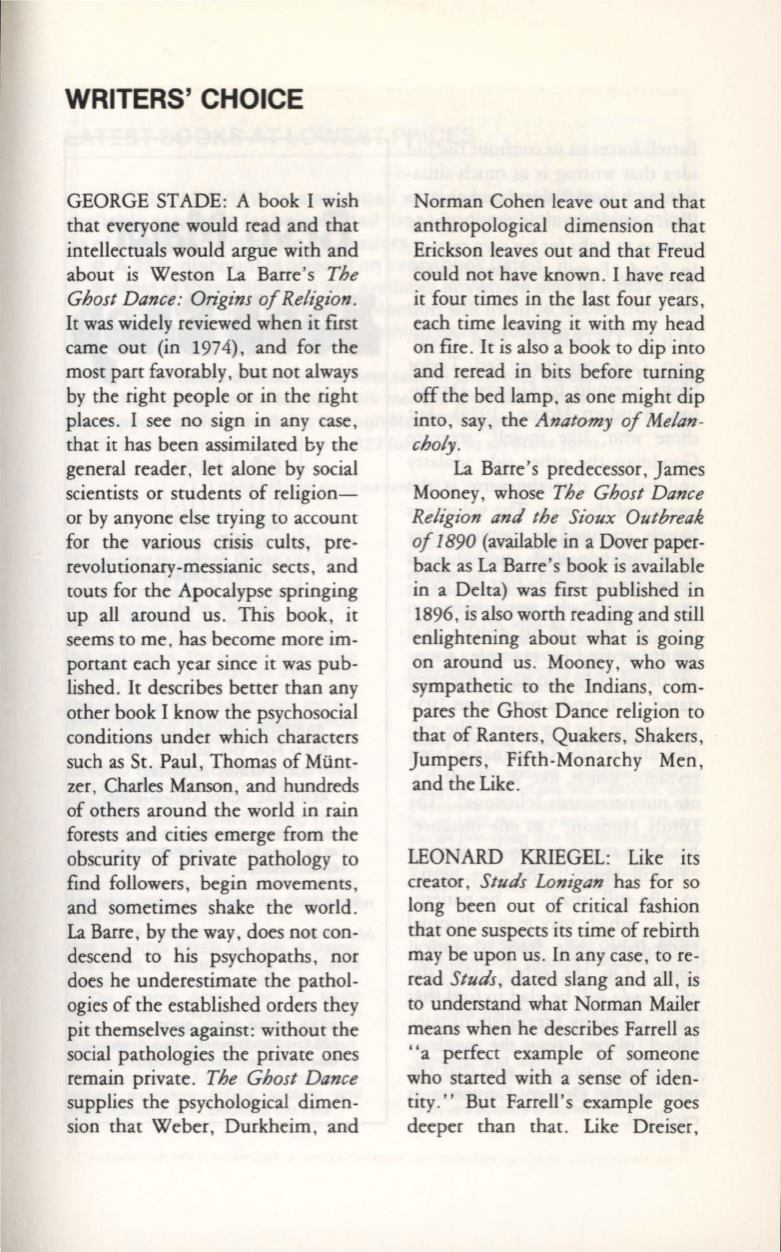
WRITERS' CHOICE
GEORGE STADE: A book I wish
that everyone would read and that
intellectuals would argue with and
about is Weston La Barre's
The
Ghost Dance: Origins ofRelt'gion.
It
was widely reviewed when it first
came out (in 1974), and for the
most part favorably, but not always
by the right people or in the right
places . I see no sign in any case ,
that it has been assimilated by the
general reader , let alone by social
scientists or students of religion–
or by anyone else trying to account
for the various crisis cults, pre–
revolutionary-messianic sects, and
touts for the Apocalypse springing
up all around us . This book, it
seems to me, has become more im–
portant each year since it was pub–
lished .
It
describes better than any
other book I know the psychosocial
conditions under which characters
such as St. Paul, Thomas of Munt–
zer, Charles Manson, and hundreds
of others around the world in rain
forests and cities emerge from the
obscurity of private pathology
to
find followers, begin movements ,
and sometimes shake the world .
La
Barre , by the way, does not con–
descend
to
his psychopaths, nor
does he underestimate the pathol–
ogies of the established orders they
pit themselves against: without the
social pathologies the private ones
remain private .
The Ghost Dance
supplies the psychological dimen–
sion that Weber, Durkheim, and
Norman Cohen leave out and that
anthropological dimension that
Erickson leaves out and that Freud
could not have known . I have read
it four times in the last four years,
each time leaving it with my head
on fire .
It
is also a book to dip into
and reread in bits before turning
off the bed lamp, as one might dip
into, say, the
Anatomy of Melan –
choly.
La Barre 's predecessor, James
Mooney, whose
The Ghost Dance
Relt'gion and the Sioux Outbreak
of 1890
(available in a Dover paper–
back as La Barre's book is available
in a Delta) was first published in
1896, is also worth reading and still
enlightening about what is going
on around us . Mooney, who was
sympathetic to the Indians , com–
pares the Ghost Dance religion
to
that of Ranters , Quakers, Shakers,
Jumpers, Fifth-Monarchy Men ,
and the Like .
LEONARD KRIEGEL: Like its
creator,
Studs Lonigan
has for so
long been out of critical fashion
that one suspects its time of rebirth
may be upon us. In any case , to re–
read
Studs,
dated slang and all, is
to understand what Norman Mailer
means when he describes Farrell as
"a perfect example of someone
who started with a sense of iden–
tity ." But Farrell 's example goes
deeper than that. Like Dreiser,


